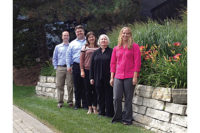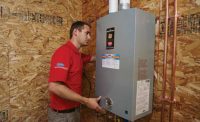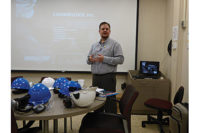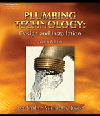
The remote Capitol Reef Field Station in central Utah at one time had extreme water hardness
issues. Photos courtesy of Greg Reyneke/Intermountain Soft Water
Greg Reynekehas what he calls a “scary scale” to rank the level of difficulty for the jobs he works on. A recent water treatment project in Uganda received a perfect 10 on the scary scale.
“It was a bakery in Uganda,” he explains. “This was a complex project since we could not visit the jobsite because of the tough political climate. We had to work remotely through the charitable national governing organizations and local subcontractors. This was a community set up to help impoverished people. There was a bakery, a butcher and a school. The pits they dug for sewage drained into one of the drinking water wells, resulting in fecal cross-contamination into the aquifer. When Johnny goes to the bathroom, Suzy is drinking what Johnny deposits. The water test came back so full of bacteria that even touching it with your hands could cause serious bodily harm. There was no equipment available to drill new wells and the entire community was at risk.”
In order to solve the problem, Reyneke, general manager of Orem, Utah-based wholesalerIntermountain Soft Water, deployed a filtration system that sequesters bacteria.
“It cost less than $1,000,” he says. “One thousand dollars made the difference between life and death. I was worried about people dying. The dire consequences of failure made this a very scary and important project.”
Intermountain Soft Water and its network of regional representatives have been providing innovative water treatment solutions around the globe since 1966. “You need someone that is not a one-trick pony,” Reyneke states. “We look at projects holistically and cover the bases. We’re not just selling one product all the time. You can’t do one size fits all when it comes to water problems. If there is a really difficult project or something complex, people come to us because we have the experience and the expertise.
“A traditional wholesaler may say, ‘Tell me what you want and I will get it for you.’ Water treatment is a little more complex than that. There are things people don’t understand and are often not aware of. What is the end goal you need to reach? We will help you get there. If the solution is something we don’t sell, we’ll put you in touch with someone who does.”
Reyneke and his crew encountered a major water problem at the 378-sq.-mi.Capitol Reef Field Stationin central Utah. The earth science research station, nestled in a picturesque canyon setting in a desert climate, is a joint effort between Utah Valley University and the U.S. National Parks Service. The solar-powered village allows researchers and students to gain experience in the field. However, the station’s location is remote. It’s located nine miles from the visitor’s center and there is no cell service or other utility infrastructure.

Plumber Jared Anderson lowers SJE-Rhombus float controls into the main
finished water storage tank.
Eye-popping numbers
Reyneke, a Pretoria, South Africa native who worked as an electrical engineer before being “bitten by the water bug,” was tasked with solving the solar-powered village’s extreme and chronic problems with hard water and other contaminants, specifically in the complex that houses researchers and students.“They need water for all the students that stay there; water for cooking, bathing and drinking,” he says.
Statistically, Reyneke explains water measuring more than 1 grain per gallon is considered hard. Anything measuring 13 to 15 grains is extremely hard.
“This place was averaging 77 to 120 grains per gallon,” he states. “It was unbelievable. If there are 7,000 grains in a pound and 25 people there are using water and each one uses 20 gallons a day, that’s 50,000 grains of hardness every day. That means they are processing 7 pounds of solid rock through the building each day it is in operation. That can’t happen. It was scary. In addition to hard water problems, the water was completely unsuitable for human consumption due to iron, sulfates, tannins and nitrate contamination.
“There was enough stuff in there to make animals sick. It was a step down from drinking swamp water. If you drank that water you would have a very bad case of diarrhea. The level of contamination would destroy any water-using fixtures. We had to get rid of it.”
Further complicating matters was the insistence that no chemicals be injected into the water. “Anything that went in there had to be approved by the park service and the state,” Reyneke says. “They wanted nothing being discharged back into the ground that wasn’t there when we started except for human waste.”

Air
injects under pressure into the water before it feeds into a retention tank.
This is the iron reacting to the air.
Getting creative
Reyneke teamed withJared Anderson, owner of Ephraim, Utah-basedJared Anderson Plumbing, to solve Capitol Reef’s water woes as organically as possible.“We wanted to try and keep it as low-impact as we could,” Anderson says. “When we first started to look at things and calculating what it would take to soften the water, Greg said it would be like taking a semi truck full of salt in once a month to take care of that kind of hardness.
“There is nowhere to discharge that type of water. With the remote location, you couldn’t get a semi truck in there on a regular basis. We wanted to make it as green as possible with no impact on surrounding plant life and everything else there.”
The first step in the process involves adding air to the raw water. Air is injected under pressure into the water and that water goes into a retention tank. The air reacts with the metals in the water and rusts them out. The iron gets rusted out and turns into, as Reyneke puts it, “a nasty, disgusting powder.”
Hydrogen sulfide gas also oxidizes into a powder and goes into the first bank of filters. Those filters hold onto the sediment and prevent it from going to the next step of treatment.
“We’re using nature to try and fix nature,” Reyneke says. “The air is free and the pump we use is solar-powered.”

The water treatment room
includes the Watts anti-scale system (black
tank on far right), which makes the subsequent nanofiltration and antibacterial
processes possible.
(Editor’s note: Reyneke is holding a beaker of OneFlow media on this month’s Supply House Times cover.)
The nanofiltration portion of the system is extremely critical to the overall water treatment process at the station.
“It concentrates and isolates contaminants at the molecular level,” Reyneke says. “We’re filtering all the way down to .001 micron. You have filthy water coming in and clean water exits the other side. We essentially concentrate what comes out of the ground. If X comes out of the ground, we’re putting 10X back into the drainage field. The product water with a fraction of X left in it goes into the building. We’re not adding anything to the raw water, we are just taking some of it out in a highly purified form. The rest goes right back into the ground where it came from. It’s an esoteric concept to grasp.”
In addition to the Watts OneFlow anti-scale device, the system includes Pentair tanks and control heads, a GE HomeSpring ultra-filter, Pulsatron redundant chlorination equipment, Charlotte Pipe piping, Sioux Chief headers and copper-to-plastic adapters, Mueller valves and fittings and Goulds’ pumps.

Intermountain
Soft Water’s sustainable practices include the use of four Smart cars.
Green success
Sustainability is a point of emphasis at Capitol Reef. The station is entirely off-grid. Reyneke found out about the station’s green doctrine when he once pulled up in a Ford Excursion.“The woman running the place said it was unacceptable,” he says with a laugh. “We weren’t green enough. We actually have four Smart cars. The next time we showed up in one of the Smart cars.”
Intermountain preaches sustainability through green packaging, reusable pallets and containers and limiting paper consumption through electronic filing and documentation. The company has specialized water purification software to eliminate waste and maximize efficiency.
“Green is a buzz word, but it makes sense,” he says. “We do our jobs responsibly and economically and have less of an impact. We’re not doing the granola thing. We’re pragmatically green.”
The water filtration system at Capitol Reef has produced sterling results. “Harvesting water in the desert is a challenge,”Utah Valley UniversitySenior Director of Planning and DevelopmentFrank Youngstates. “But with the help of Jared and Greg and some very reliable, smart technology, we’re able to meet that challenge and also be a great deal more conservative with our natural resources.”
Reyneke has received similar positive feedback. “The results have been phenomenal,” he says. “Everybody is tickled pink. It does require onsite maintenance and a plumber goes down there once a year to perform maintenance and an occasional filter change. It works incredibly well.”
This was Anderson’s first time working with this type of water filtration technology. “It definitely opened my eyes to other solutions,” he states. “It fit the job. It was exactly what they were looking for. We didn’t use any power and didn’t negatively affect their solar system. It has a low impact on anything in the surrounding area. It’s not every day you run into a job like that.”
So where does this project rank on the scary scale?
“There was a lot of regulation and they had big problems,” Reyneke says. “It was 7 out of 10 on the scary scale, but we made a big difference.”









